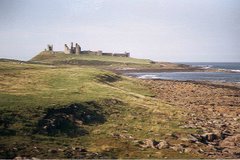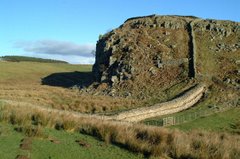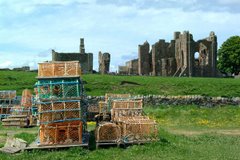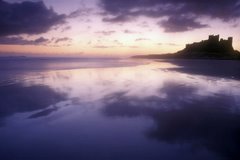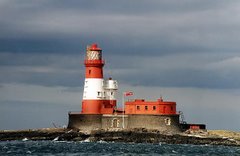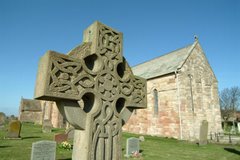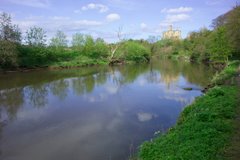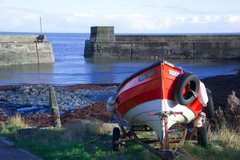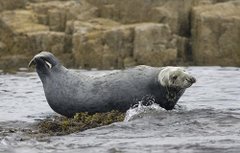I'm scraping the barrel once again in my whistle-stop tour of (arguably) England's most beautiful county. This time we're at Blyth - home of not-so-golden beaches, pollution, crime and unemployment. Kind of like
Ashington, but slightly less glamorous and easy on the sinuses. On a positive note it does have some 'canny' people (as we say around these parts), innovative technology on Kitty Brewster industrial estate, loads of cheap continental retail outlets (you know the ones) and the wind turbines are making a positive contribution in the fight against global warming. Rumour has it you could once catch fish in the harbour but now you only get supermarket trolleys and burnt-out cars. The local Labour MP is Ronnie 'the Monkey' Campbell - so called because he was too stupid to complete his own time sheets down the pit. Blank out the vision that he is now stalking the corridors of power. He's also not a man to mess with arguing over a kebab (allegedly). As Ronnie would tell you, if he could string a coherent sentence together, despite it's limitations Blyth is still a good place to get a decent bag of chips.
The Earls of Derwentwater owned Blyth and the surrounding land up until 1716, when the third and final Earl was executed after the 1715 Jacobite rising. In 1723, the land was bought by Matthew White and his brother-in-law Richard Ridley, with accumulated fortunes from town-based trades. By 1730, Matthew White extended his landed possessions by purchasing Blagdon, which still remains the seat of his descendants.
The port of Blyth dates from the 12th century, but the modern town of Blyth only developed in the 18th century, with the erection of a quay for the shipment of coal. There were also fourteen salt pans with an annual production of over one thousand tons. The industry closed in 1876 with the destruction of the last saltpan.
Nevertheless, the port continued to prosper. By 1853, the Blyth Harbour and Dock Company was formed, and five years later, the harbour was dredged, allowing a substantial increase in the coal trade: increasing from 250,000 tons of coal being exported in 1855, to 3 million tons by 1900.
Shipbuilding records go back to 1748 but only rose to a formidable level after the beginning of the 20th century, when it developed one of the largest shipbuilding yards on the North East coast with five dry docks and four building slipways. During the First and Second World Wars, the Blyth shipyards built many ships for the Royal Navy including the first aircraft carrier, HMS Ark Royal in 1914. The shipyard was closed in 1967.
The fishing industry also played a significant part in Blyth's development with many people engaged in the salmon and herring industries in the months of August and September.
In 1831 there were 246 inhabited houses combined with a total population of 1,769. By 1931 this had risen to 7,218 inhabited houses with a total population of 31,680.
During the Second World War Blyth Harbour was a submarine base.
Blyth has been seriously affected by the running down of the coalmining and shipbuilding industries but the port of Blyth still remains a major industry in the area with the shipment of paper and pulp from Scandinavia for the newspaper industries of England and Scotland. It is also a dormitory town with substantial new housing estates. There are two trading estates in Blyth, namely Cowpen and Kitty Brewster.
Cambois, just north of Blyth, was the site of a large coal-fired power station. It opened in 1958 and closed in January 2002. The chimneys were demolished on December 7, 2003. Blyth pier (which protects the entrance to the river from the sea) has been home to nine wind turbines since 1992, joined in 2000 by two offshore wind turbines 1km out to sea. At 2MW each, they were when installed the largest in the world.
The town is home to one of England's best-known non-league football clubs, Blyth Spartans.
Article adapted from the
Wikipedia online encyclopedia.
How to get to Blyth:By road from the south: take the main A189 trunk road north from Newcastle. Blyth is about 12 miles north of Newcastle.
By road from the north: Take the main A1 trunk road from Edinburgh and Berwick upon Tweed to Alnwick, about 30 miles south of Berwick. Turn off at Alnwick and take the A1068 coastal route. Just south of Ellington join the A189. Blyth is on the left just after the Ashington turn off. Head for the wind turbines.
By rail: The nearest station is Cramlington.
By bus: Services 42, 43, 101, X1 and EX1 (plus many others) connect Blyth and Newcastle upon Tyne.










